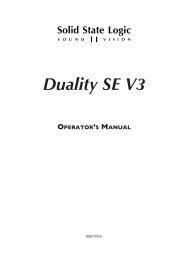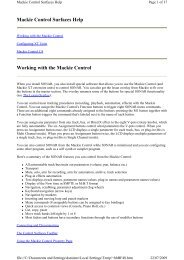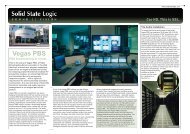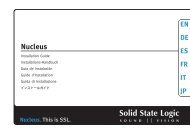AWS 924-948 - Solid State Logic
AWS 924-948 - Solid State Logic
AWS 924-948 - Solid State Logic
- No tags were found...
Create successful ePaper yourself
Turn your PDF publications into a flip-book with our unique Google optimized e-Paper software.
Analogue OperationsDynamics OperationWhile the Stereo Bus Compressor controls are self explanatory, the two compressor/gate sections require a word or twoof explanation:The dynamics may be assigned singly or as a pair to any channel using the Dynamics 1 and 2 buttons on the channel meterpanel. Alternatively, they may be assigned to the Record or Mix busses by means of the DYN function on the main bus selectpanel. In this case, Dynamics 1 is used for the left bus, Dynamics 2 for the right bus.The dynamics sections are located below the track bus meters. The compressor makes up the top half of each section, andthe gate makes up the bottom half. Both compressor and gate use the same gain element.The IN button at the bottom of the gate switches the entire section in and out of circuit.The yellow and red LEDs indicate the amount of gain reduction the compressor section is applying. The green LEDs indicatethe amount of gain reduction applied by the Gate/Expander section.The LINK button towards the base of the gate links the sidechain signal of that unit to the sidechain of the other dynamicssection. The control voltages are then summed together, so that whichever section has the most gain reduction will controlthe other section. This is most useful when using both dynamics sections on a stereo signal.The KEY button at the bottom of the gate enables a dynamics section to be controlled by an external source signal.Compressor/Limiter SectionRATIO: When turned to 1:1, the compressor/limiter section is inactive. Turning the controlclockwise increases the compression ratio, giving a true limiter when fully clockwise.PK:The compressor normally has an ‘over-easy’ characteristic. Pressing PK switches this topeak sensing, and replaces the ’over-easy’ characteristic with a hard knee.THRESHOLD: This controls the level at which the compressor starts to act.Automatic gain make-up is provided, to maintain a steady output level as you introduce more compression.FST ATK:RELEASE:Normally the attack time is program dependent (3ms – 30ms). Press this button to selecta fixed fast attack time (3ms for 20dB gain reduction).Sets the time constant (speed) with which the compressor returns to normal gain settingsonce the signal has passed its maximum.Gate/Expander SectionThis section can act as an ∞:1 Gate, or as a 2:1 Expander when the EXP button is pressed.RANGE: Determines the depth of gating or expansion. When turned to 0 the gate is inactive. Whenturned fully clockwise, a gate depth of 40dB can be obtained.THRESHOLD: Determines the level at which the gate opens or below which gain reduction begins (EXP selected).Adjustable from +10dBu to -20dBu. Variable hysteresis is incorporated in the threshold circuitry to preventspurious triggering of the gate when the signal is close to the threshold level. This means that the signalhas to decay roughly 2dB below the threshold level before the gate will start to close.FST ATK: Normally, a controlled linear attack time of 1.5ms per 40dB is provided. Press this button to select a fastattack time (100µs per 40dB). The attack time is the time taken for the Gate/Expander to ‘recover’ oncethe signal level is above the threshold. When gating signals with a steep rising edge, such as drums, a slowattack may effectively mask the initial THWACK, so you should be aware of this when selecting theappropriate attack time.RELEASE: This determines the speed at which the Gate/Expander reduces the signal level once it has passed belowthe threshold, variable from 0.1 to 4 seconds. Note that this control interacts with the RANGE control.HOLD: Determines the time after the signal has decayed below the threshold before the gate starts to close.Variable from 0 to 4 seconds.Page 3-22<strong>AWS</strong> <strong>924</strong>-<strong>948</strong> Owner’s Manual
















